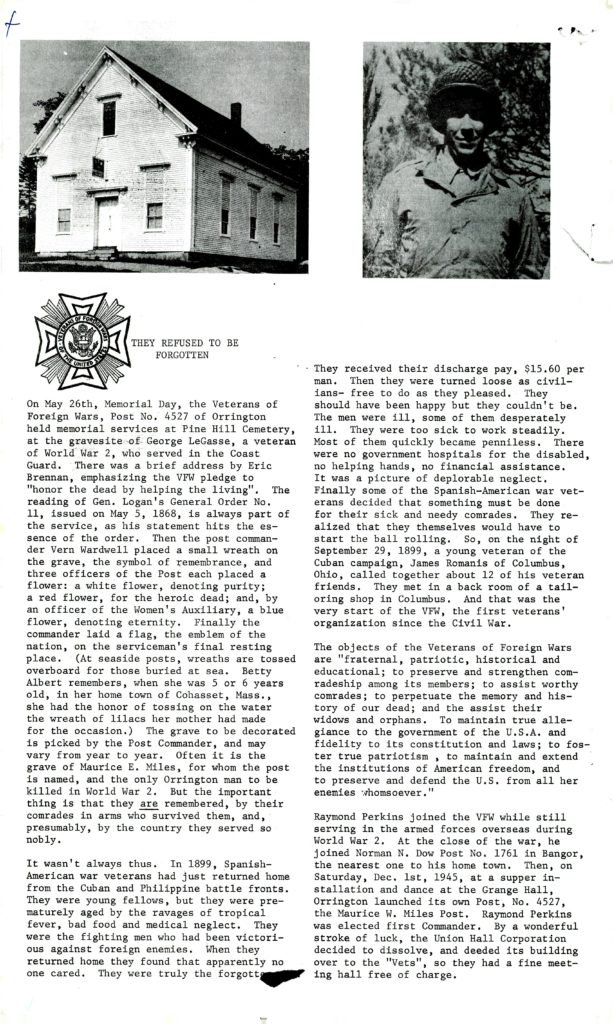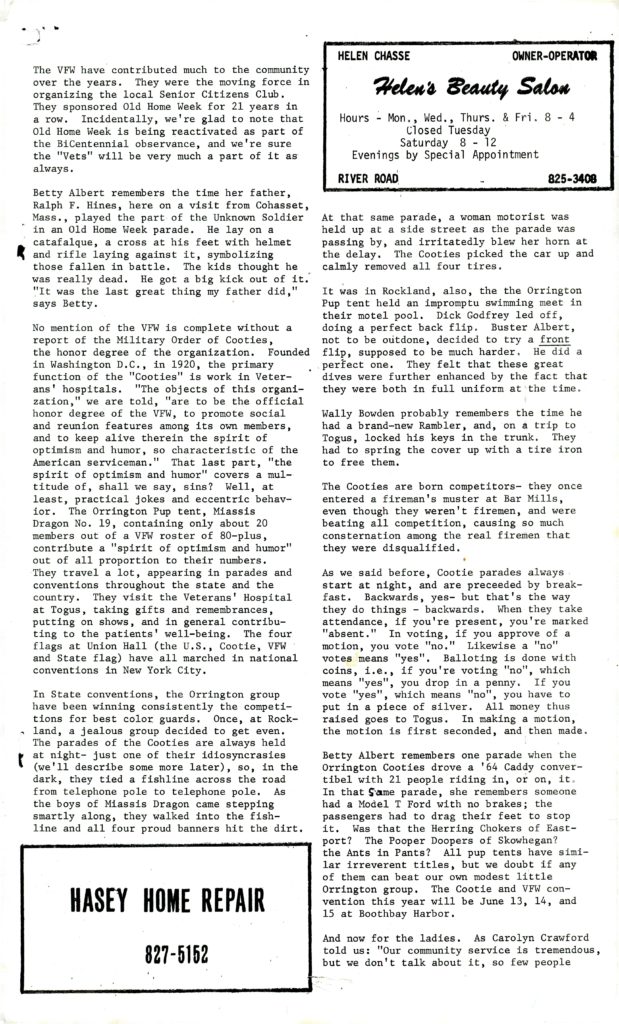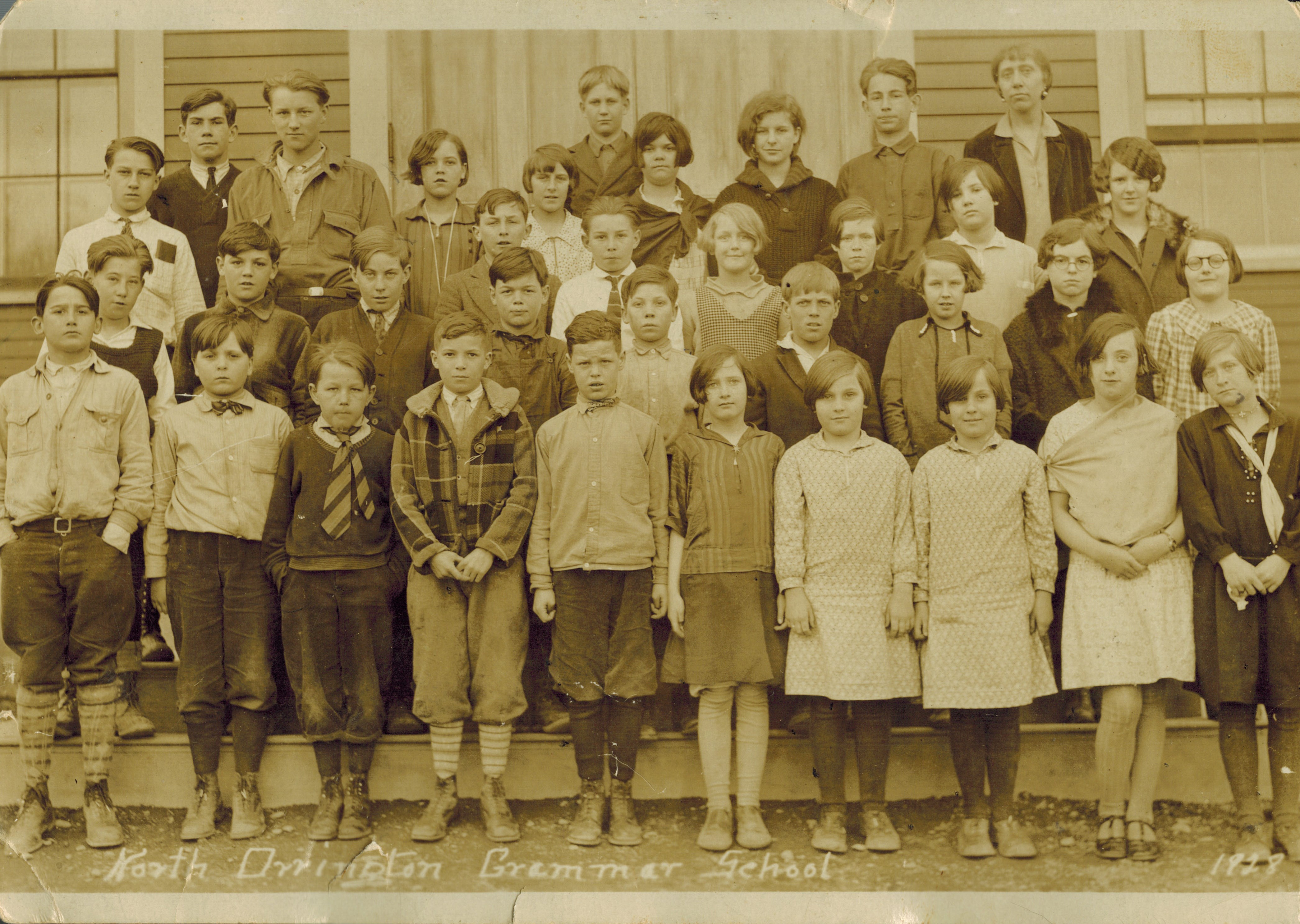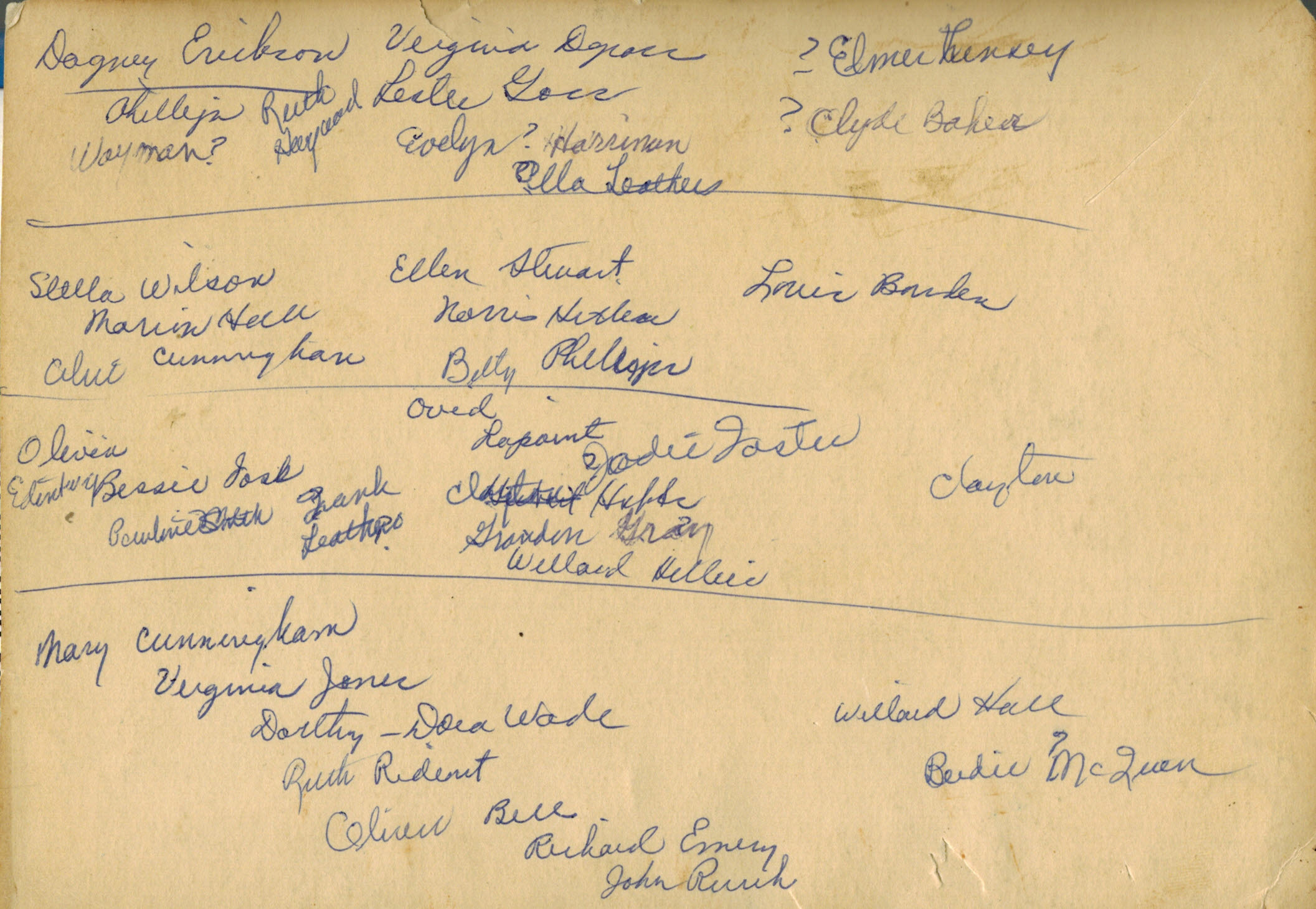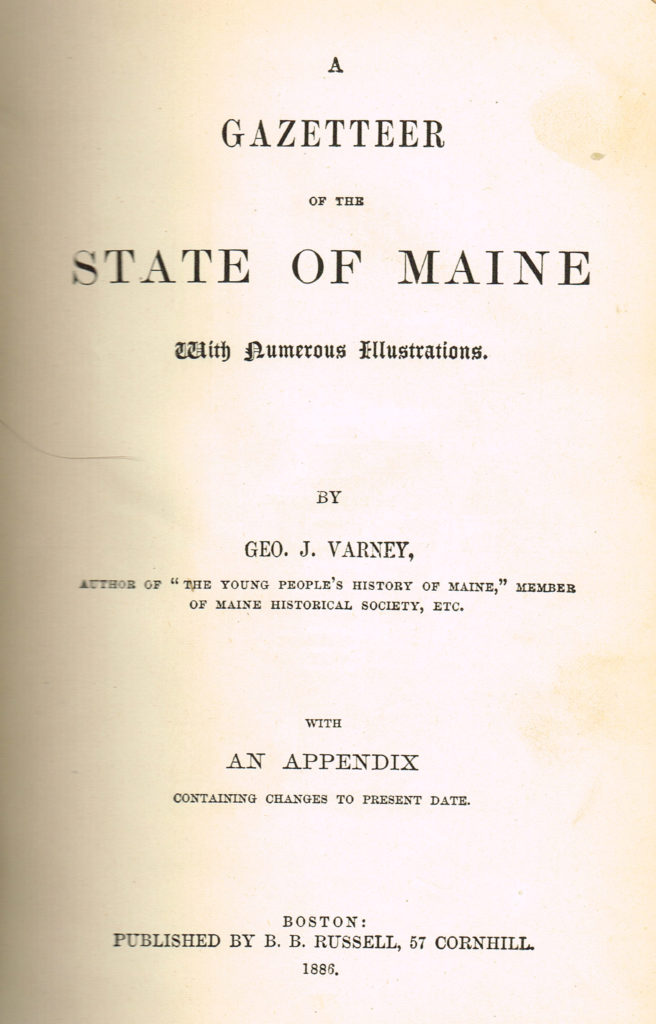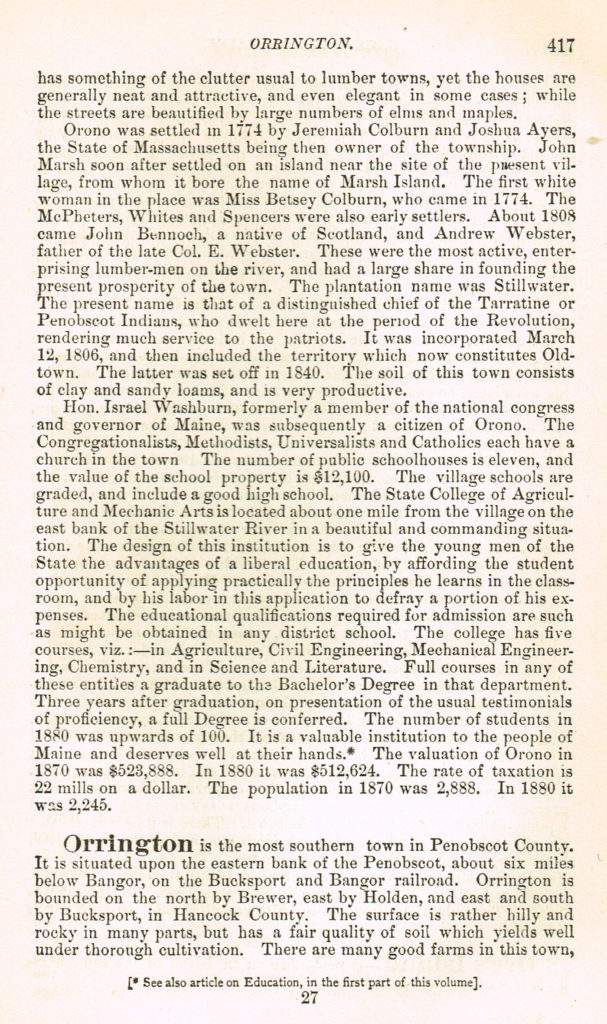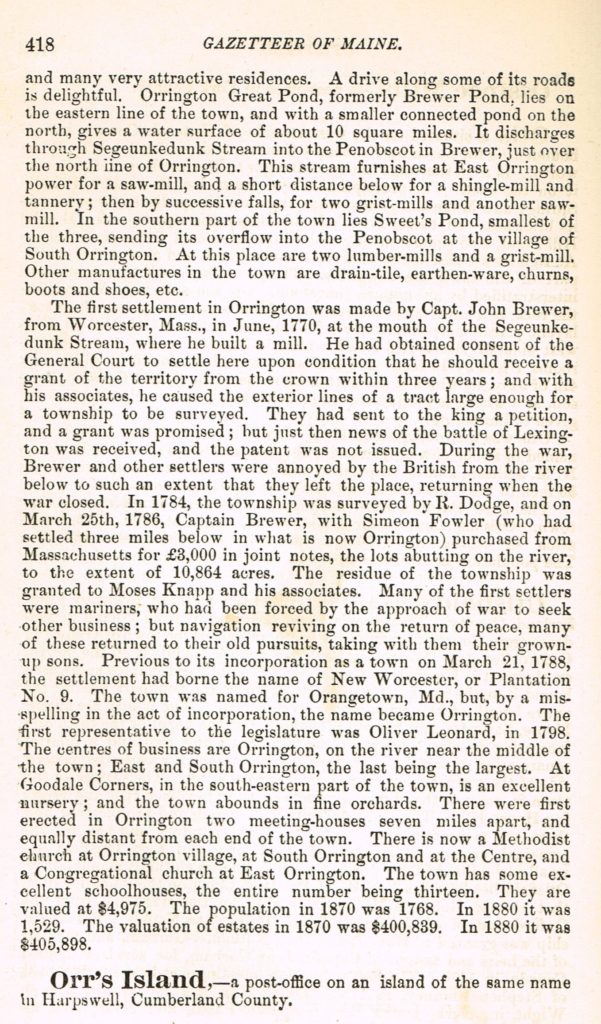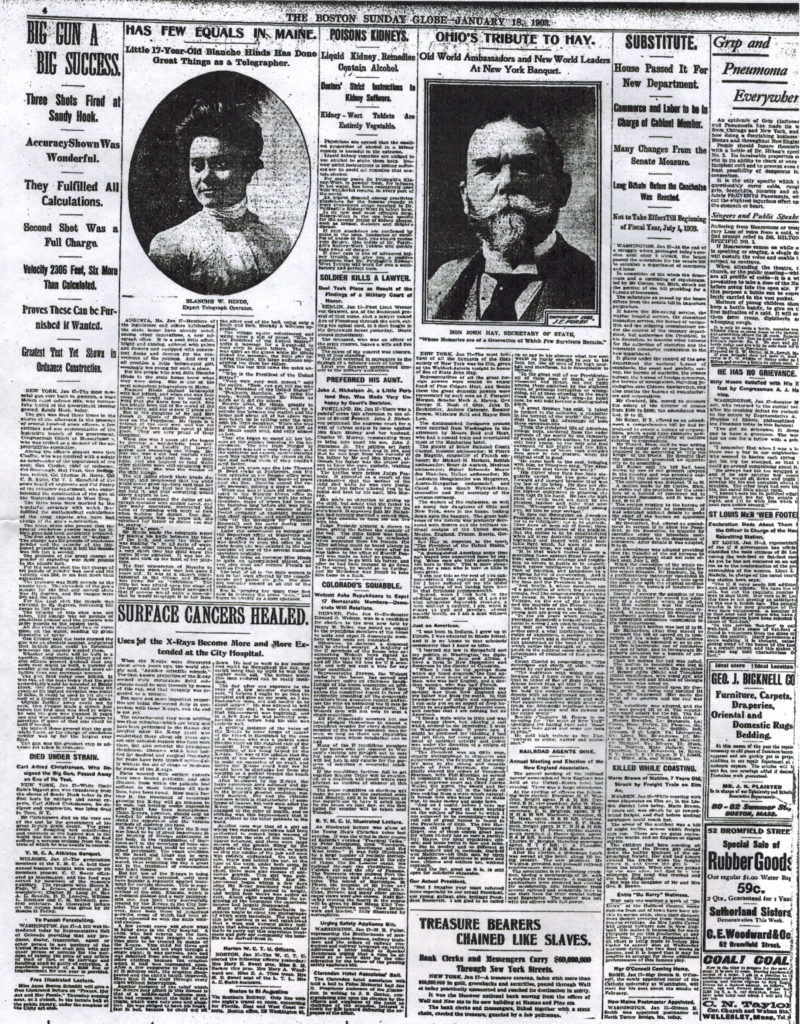The following excerpts are from the December 16, 1971 Special Edition of the New Gazette, a newspaper published as a community service project by the Orrington Jaycees. These excerpts were transcribed by Pauline Bickford-Duane in July 2017.
THE NEW GAZETTE
Special Edition
December 16, 1971
SPECIAL ANNOUNCEMENT
It is with mixed emotions that I make the following announcement: The business of the S.S. HERRICK & CO., also known as HERRICK’S, will cease operation on December 31, 1971.
There has been a HERRICK’S STORE at 590 So. Main Street, Brewer, for 92 years. Last year during the Maine Sesqui-Centennial Celebration HERRICK’S was honored by recognition for being the second oldest grocery store in the State of Maine under continual operation by the same family at the same location. The oldest store was Frisbee’s Market at Kittery Point.
Sewall Herrick started his business in 1879 and served the people for 60 years, then his son Winslow Herrick took over the business, made many changes to better serve the people for 26 years, and then I, Jeanette Wiswell, bought the business and continued the Herrick tradition for six years. I now feel that there is no real need for this type of business and rather than to make changes to conform to the present need, I prefer to retire and enjoy a few years of relaxation and pleasure while I still have good health.
My first thought was to “close out” but on second thought I realized the need of a grocery store on this particular corner and felt that I could continue to serve the people if I could find someone worthy to take over. So – although I am sorry to announce the closing of HERRICK’S, I am glad to announce the opening of MACDONALD’S.
I was very fortunate in finding a young man of good character, Richard MacDonald, a resident of Brewer, and present owner of two grocery stores in Bangor, who was glad to buy my business and is prepared not only to carry on, but to serve you further by changing the store hours to “8:00 A.M. to 10:00 P.M. 7 Days a Week.” He will also employ Frank Phillips to serve you at the meat counter.
So – with my feelings of sadness to leave and my feeling of hope and happiness for the future, I make this announcement.
NOTE: Miss Dagny Erickson, a former schoolteacher in Orrington and Brewer, has written a book entitled “From Norway to Nostalgia” and has kindly permitted us to use excerpts from this book which you will find in this issue of the Gazette.
Jeanette Wiswell
AN INTRODUCTION
Although Herrick’s store had had its beginning many years earlier, it was not till the year 1907 that we came to know it – better than most perhaps. Its history then was well known, and we learned of its start on Main Street, as a sort of ships chandlery business, then expanding its services to provide lumbermen’s supplies and general merchandise. Needing more room, the owners had moved the growing concern to its present location at the corner of Main and Elm. One of its earliest owners was a Captain Drake who later moved to Boston, leaving the young enterprise in the hands of Harlan Sargent. It was at this point that Sewall Herrick came into the picture, and became a partner. However, in the course of a few years, the sign over the door read S.S. Herrick & Co. – changed some years later to S.S. Herrick and Sons.
Every family in South Brewer, and many more in Orrington, had good reason to hold in high regard the convenient, dependable general store and its efficient, friendly personnel. But our family’s position for accurate appraisal and unbiased appreciation was a unique one. Recent immigrants from Oslo, Norway, we found ourselves set down in a strange environment, which was held together by four focal points that spelled security: school, the sawmill, church, and Herrick’s.
The store has been modernized in recent years into an effective, attractive self-service mart, with the necessary refrigerated units and two check-out counters. Nevertheless, it can never reach the picturesque peak of the early decade in the present century.
In my book, “From Norway to Nostalgia,” I have devoted an entire chapter in an effort to do justice to Herrick’s, both then and now. A few excerpts from that may do more to enhance its memory than bare outlines, and cold statistics.
Dagny Erickson
CHAPTER X
DEMOCRACY – FULL MEASURE
Situated across Main Street from our house was a local institution which contributed as much to the Erickson tribe’s early education here as did the school itself. It was that solid segment of small town America called, usually, the “general store.” Standing foursquare on its firm foundation of red brick, it faced the western sky, the wintry blasts, and the ever-growing demands of a population that believed in living well. Over its main entrance hung a sign which read S.S. Herrick and Co. Through its three doorways and within its well-built walls moved and functioned all the elements, all the ingredients of New England democracy at its very best. Over the broad boards of its bare floors, worn splintery and grooved, walked a cross-section of humanity on equal footing. Laborer or lumberman, farmer or fisherman, retired sea captain or limping veteran, each took his turn and was served, according to his needs, with the best available at the time.
Some well-to-do individuals, independent as a “hog on ice,” paid “cash on the barrel head.” Others living on monthly incomes “ran bills,” as did the mill-workers who squared up each Saturday night. Then there were those who, hit by sudden financial emergencies, got behind, but obtained what they needed through their difficult time even if the future, too, looked grim and uncertain.
Unlike many similar places of business throughout this section of the country, loitering was not particularly encouraged at Herrick’s nor was pompous oratory any part of the day’s dealings. Anyone who had a cargo of opinions to unload had to find more willing ears elsewhere. Verbiage beyond the necessary oral order was brief and to the point. Anything more would have been redundant in the face of the proprietor’s own taciturnity. Besides – everyone was much too busy. Occasionally a farmer sat down at the flat-topped stove to warm himself, while his wagon was being loaded at the store-room platform; and if there happened to be a lull in the meat department Mr. Herrick might leave his private domain to enjoy a pipe and the warmth with his customer. But usually the farmer helped to load his feed and grain and household staples himself in order to speed the operation. Very likely he had long miles to cover with his slow team, and to get home in time for mid-day chores or the evening milking was as inevitable – a must – as Franklin’s “death and taxes.”
Children came and went on errands for their elders or to hover over the candy case with sticky pennies clutched tightly in their greedy hands. Each one, in spite of age, sex, or position, had to adhere to the highest standard of personal conduct or suffer the consequences. The rules of decorum for anyone under eighteen were set up and enforced by a peppery spinster who occupied, full-time, the bookkeeper’s cubicle in the exact center of the store.
Perched high on a “Bob Cratchet” stool, she kept most of the store under constant surveillance and nothing within her line of vision went unnoticed. Children were the bane of her existence and it might have pleased her well had the natural order of things provided that adults should arise, full-blown, from the sea like Botticelli’s “Venus.” Little girls, quiet and primly starched, or tousled-headed boys with one knicker leg properly anchored at the knee, the other sloppily dangling halfway to the ankle, got the same fault-finding treatment. If any one of us came precipitously through the door, she accused us of slamming it; a slow careful entry “caused a draft,” a purposeful walk down the aisle to the order desk brought the rebuff, “Get back, you’re in the way.” An indecisive stop, part way between the orange crates and the pot-bellied stove, produced a shrill “What are you doing way down there?”
So, philosophically, we gradually adopted and followed a chalk-line course down the middle of her varied do’s and don’t’s but rarely, on the way out, closed the door behind us entirely unscathed.
Many of the scars on my tender memory healed miraculously one day when I heard her tell a grizzled walrus of a man that he didn’t know his own mind. And he, who had sailed the oceans of the world, in storm and in calm, as mate and as captain, merely shook his head and grunted.
But she had her virtues too. Like the village doctor, she knew the rattling skeletons in assorted closets all over town, but never a hint of gossip was ever laid at her door.
The clerks were kindly men with well developed capacities for patience. This quality was most apparent when we were vacillating between the candy display and the pickle barrel. A penny’s worth of candy meant, at best, no more than two delightful gulps; a huge, sour cucumber, combined with a few crackers, promised at least an hour of careful nibbling. It was a momentous decision and the clerks shared the strain.
Fred Ware was our favorite. He was a deacon at the church and leader of our Junior Christian Endeavor Society. To our benighted souls, his fund of biblical lore made him the fount of all knowledge and as such we properly revered him.
Then there was Abe who lacked all the attributes of manly beauty, besides being extremely sharp-nosed and cross-eyed. We saw little of him, as he was driver of the team that made all the daily deliveries. Mornings he went “up the road,” afternoons, “down the road” and into North Orrington. During the gaps between, he filled orders and worked on his accounts. Not long after our arrival he left the store to take up poultry farming in East Orrington. This change, on his part, brought about the first removal of old landmarks in our neighborhood. The ancient bandstand that had graced the southeast corner of “our flat” for many a long year was carted majestically on a low jigger to Abe’s new property. Here he converted it into a henhouse. Such a come-down for a temple of music!
All the clerks wore hats while at work and I remember Mr. Smith simply because his was a hard straw skimmer of the boardwalk variety. He wore it at a rakish tilt toward his left ear that went well with his dapper, bow-tie personality. His cool nonchalance was the only effective weapon against the bookkeeper’s acid attacks and she found him mildly amusing. Once I actually saw her horizontal lips turn upward ever so slightly at one of his quips. During the tornado, already described, when the clapboards on the flat became airborne, a goodly number of them crashed through Herrick’s plate glass windows, and our Mr. Smith, missing his cue to duck, was badly cut by flying glass. Luckily he was the only casualty.
Sewell Herrick was one of the kindest men I have ever known and that knowledge came to me when I was in a position where every direction was up. Had such a sentiment about him been noised around and come to his ears, it would have roused his mighty wrath. He was essentially a quiet, retiring man who lived the golden rule without the accompaniment of clashing cymbals. Lean, sparse,a graying whisp of a man, compared to my Dad’s towering stature, he seemed made of steel springs and possessed a dry wit which is often an asset of those who think much and listen well. Very likely much of his humor fell on uncomprehending ears, for it became doubly subtle because of his frugal use of words. Whether it was fear or awe, it is hard to say, but none of us ever took any liberties with his abounding good nature.
Under Dad’s first “division of labor” plan it fell to my lot to get our daily supply of groceries. The boys did not fare so well. On general principles, we objected to anything in the nature of a chore because it came under the heading of work. But Ted and Bjarne were more than justified in the struggles against the back-breaking task Dad set for them. Martin was still too young to participate, and besides, he had developed a quicksilver agility about wriggling out of any situation that might involve him unpleasantly.
Dad’s job, which was a sort of piece work arrangement, gave him a fringe benefit which became the boys’ daily duty to collect. In bunching the strappings, which were of varying lengths, Dad had to saw off the protruding ends after the bundle was securely tied with tarred rope. These odds and ends of wood were his for the taking, and as they were excellent fuel for a quick, hot fire they had to be toted home. A heavy iron wheel barrow was borrowed from the mill and then loaded from beneath Dad’s “horses.” It was a long trek to the house, first up over the steep muddy slope from the mill yard, to the edge of a rutted Main Street, through the deep puddles at the town pump and up slopes of a wide valley at the edge of our own strip of front lawn. By the time the shed door was reached, there was hardly enough left of the load to fill the woodbox once. All the way back to dad’s position was a sawdust trail dotted with assorted pieces of glistening “green” wood, so a pick-up trip had to be made lest Dad should follow the well-marked path and object to its convenience. After trundling the barrow himself a few times, he hired a man with a dump-cart to haul us a weekly supply and thus ended one area of “durance vile” for the two boys.
My task of going to the store was not that difficult, but neither was it entirely simple. This was before the days of self-service and a customer at Herrick’s was expected to stop at the order desk, hand over his “store-book” and give his order. This was written down, item by item, in the small ledger carried back and forth, and also scribbled off in the big ledger on the counter. The clerk then roamed around, gathering your supplies while you waited. This method was obviously impossible for me. My vocabulary at that time contained very few English words that in any way pertained to groceries. But Dad had made arrangements at the store so I would be permitted to do my own roaming with a clerk in tow. Pointing to the things I wanted, the entire process went on with few hitches, but completely in reverse.
This was where Mr. Herrick came into my life. When not too busy he attended to my instruction himself but the clerks were told to make me pronounce each item on my list satisfactorily before I was allowed to depart. Just how they managed about quantities is a guess at this time. Perhaps, as every man had his own family and knew well the size of ours, he weighed and measured accordingly.
One morning we ran out of cocoa for breakfast and I was dispatched for another can. The business of the day had hardly gotten into full swing. Mr Herrick was free and waited on me himself. Proudly I asked for cocoa, making three syllables of it, and probably, Scandinavian style, saying “coo-coo-a.” A shrill cackle from the bookkeeper’s cage was evidence enough that my error was grotesque, and that I should, as usual, have pointed to the familiar “Lowney’s” label. With infinite patience Mr. Herrick drew a finger nail across the “a” as if to lope it off. Then taking me to the corner where the shelves of canned vegetables jutted against the bakery case he made similar imaginary lines through the a’s in bread and peas. It was my first lesson in the intricate pattern of English spelling where silent letters lurk to beset the path of the unwary.
At another time, in those earliest days, I was sent to get a scrub brush. Our soft wood floor had become hopelessly gray and Mother was on a cleaning spree. Up to this point, I had managed nobly and knew every inch of the store better than any other youngster in town. However, I could not remember seeing any brushes anywhere, so it was necessary to appeal for help. My pantomimes were “Oscar” winning performances but produced no results. Finally a clerk opened the cellar door with a “be-my-guest” gesture, and there, hanging in clusters against the sloping wall were brushes of every sort including the kind I desired. After a valiant struggle with the collection of consonants in the two words, I crossed the street in triumph.
From the front entrance, the interior of the store may have looked a bit like a repository of heterogenous abundance. However this was not so, for the planned lay-out was both simple and logical. In general, the front of the store was the housewife’s province, while in the back could be found the manly things her spouse might want.
To the left, as one entered from Main Street, a swinging screen door opened into the dry-goods and hardware department. This was a long, narrow room in which could be found oil cloth, screen netting, workmen’s canvas gloves, shoe lacings and a glass case of assorted thread. To this last, I came often and soon learned that the bigger the number, the finer the thread. Mother used no. 60 for fine sewing but bought a prodigious amount of no. 12 to sew up rips and tears, attach patches, and replace buttons in a desperate attempt to keep them secure, for more than twenty-four hours at a stretch. As for hardware there was a profusion of pots, pans, pails, tubs, lamps and lanterns, rows of bean-pots, and way up high, a line of chamber mugs.
The main store had one long counter on which were set a number of glass cases. The first of these was the tobacco case filled with plugs of both chewing and pipe tobacco. Here too, were cigars in beautiful boxes. These we much admired because on the inside open cover were colored pictures of buxom Spanish ladies with roses in their hair or between their very red lips. Usually a draped skirt was daringly lifted to display a generous view of ankle and leg. Somehow I obtained one of these prized wooden receptacles and used it to keep my hair ribbons in. The faint aroma of tobacco that clung to my person bothered me not a whit.
Back of the counter ran long shelves, well stocked with spices, extracts, patent medicines, polishes and boxes of small hardware. Along the front were crates, barrels, bins, and kegs of products from far and near. Sponges from tropical waters lay neighbor to greens from Hersey Smith’s farm; apples from Orrington blended their spicy fragrance with the citrus fruit perhaps from the Mediterranean; and in the window, hung great bunches of bananas adding color to the baskets of local potatoes and turnips that sat underneath. Once, at Thanksgiving time, a tremendous barrel made its appearance near the orange crates. It was filled with ground cork and when a clerk reached down deep he came up with immense clusters of luscious, pale green grapes. I’ve wondered many times since, did they come directly from southern Spain or Portugal where such fruits are grown and where the cork-oak tree is indigenous?
Near the big round stove stood the bakery cabinet, not very large, for most housewives did all their own baking. Store bread, sugar or molasses cookies, and “boughten” doughnuts were strictly for rare emergencies or for housekeeping bachelors. Beyond the bookkeeper’s cage was the meat room at one side and another long counter on the other. At one end of this counter sat a great round cheese under a glass dome. It was a source of great interest to see how accurately any of the clerks could cut a wedge for a customer. Seldom did he go over or under the desired amount by more than a tiny fraction of an ounce.
There was a time when the church, the school, the doctor’s office, and the local store, jointly, made up the core of every close-knit community. But the general practitioner has become a specialist and has moved out of his dingy office and the heart of the people, and into sterile clinics or up-to-date medical centers. It would be a rare one who could thank you for mussing up his natty appearance by crying on his shoulder. Modern super markets and expanding shopping centers are snuffing out the life of the small independent grocer. We are swapping the friendly shopkeeper, who not only served his community but loved it, for bits of human automation, called check-out girls, who speed you on their way with their mechanical smiles. These changes are taking much of warmth and color from the American scene. It is too bad that the wheels of progress not only grind, but sift. Only the practical is retained; left behind are the dying embers of a glowing vitality that sprang from a sincere personal concern, one for the other.
It was my great good fortune to discover Mr. Sewell Herrick and to hear the beat of the great big heart that lay just south of the stained clay pipe usually gripped between his teeth. Under his loose vest, that generous organ was often called upon to extend itself to a troubled customer and make him a friend-in-need. And that is the image that remains with me.
Mother died on August 20. The months that followed were difficult for all of us but especially so for Dad. Not only was he left alone to cope with a family of children, but a mountain of bills had piled up to confront him. Three funerals to pay for – our two young sisters had died too – doctor’s fees and all the attendant costs, besides our daily living expenses, totaled to a financial burden that sent Dad to his work at day break and kept him there till dark. When the saw mills closed down at the first sign of ice in the cove in late November, Dad looked thin and drawn. But he took his usual winter job in the beater room at the pulp mill and continued to face his problems with cold stoicism. As the winter approached his health became worse. No matter what he ate it hurt him, and he lay around, during his brief leisure, in utter lassitude with faint pink spots tinting his cheeks. The day finally came when he was unable to drag himself out of bed, let alone attempt to tackle his daily toil. So on the advice of a good neighbor, I called the elder Dr. Thomas who came at once as he had so many times before. His diagnosis was swift and his orders peremptory. Dad had typhoid fever and the hospital was the only place for him – and at once.
The good doctor waited until the ambulance arrived, meanwhile giving me advice about how to clean Dad’s room and what to do about the heavy bedding.
As Dad was being carried out, feet first, on a stretcher, through our seldom-used front door, all the long series of family catastrophes gathered into one mighty wallop that landed squarely on my rounded thirteen year-old shoulders. Reeling under the impact, I fell against the door frame. With my forehead on the cool panel, I cradled my face in my hands and sobbed uncontrollably. The hopeless tears bounced off my bony cheeks and splashed on my stringy, tired arms. The man at my side, accustomed to grief and despair, placed his hand gently on my bent head and left, closing the door quietly behind him.
It never occurred to any one of us that Dad might die and that his tall frame would never again walk in at the door. To us he was indestructible and an ever present force to be reckoned with. No, my greatest worry those gloomy winter days was the staggering balance in our store-book. Nearly one hundred dollars! Einar was working, earning a dollar and a quarter per day but our supplies averaged at least twelve dollars a week. By cutting corners here and there, I tried to keep it below ten. But we were young, hearty, and always ready to eat, so the struggle was a losing battle. All at once, going to the store became a much dreaded necessity. Instead of saying, “I want this, and this, and this” I was pleading ungrammatically but humbly “Can I have…” Each day I expected a thunderous “NO.” Then it happened. The clerk at the order desk said, “Mr. Herrick wants to see you in the meat room.” I moved toward the swinging screen door much as Marie Antoinette must have moved toward the guillotine, except that the ill-fated queen carried her pride high and mine was trailing in the dust at my heels.
Mr. Herrick was wielding a cleaver as I entered so my gory simile is not too inept. But he laid it down, pulled his lank person up onto the edge of the chopping block, fondled his pipe and looked at me meditatively. And then he made what was, perhaps, one of his longest speeches. It is impossible now to quote him verbatim but the gist was clear.
The doctor had told him that Dad would be as good as new but that he would need good food and plenty of it. He (Mr. Herrick) explained that he and Dad had made a deal in the fall whereby Dad could pay off all his other bills first, letting his store account run until the following summer. Mr Herrick was troubled because I was cutting down on amounts. “A pound and a half of meat is not nearly enough for five of you, and why don’t you get eggs and fruit?” he scolded. Then, “We’ll keep your store-book here, then you won’t fret about it. Get what you want, all you want at any time. The saw mills will start again by the time your father is well and he’ll clean up his account in no time.”
I won’t wax so poetic as to say I walked home that day with my head up and a song in my heart. But I did clasp close to my ribs a substantial bundle of pork chops. From then on, my order would often be augmented by a bag of doughnuts, sugar cookies, or a wide “hand” of bananas. Whether he ever listed these extra items in our account I shall never know.
Best of all, his predictions were right. By the time the mills whistled again, Dad’s health was the best it had ever been. The horrible figures in our store-book dwindled gradually to zero and again things were reasonably right in our little world.
May the name of Herrick be blessed to the fourth and fifth generations.









